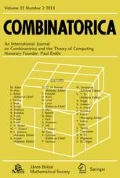Abstract
LetM be ablock matroid (i.e. a matroid whose ground setE is the disjoint union of two bases). We associate withM two objects:
-
1.
Thebases-cobases graph G=G(M,M *) having as vertices the basesB ofM for which the complementE\B is also a base, and as edges the unordered pairs (B,B′) of such bases differing exactly by two elements.
-
2.
Thepolytope of the bases-cobases K=K(M,M *) whose extreme points are the incidence vectors of the bases ofM whose complement is also a base.
We prove that, ifM is graphic (or cographic), the distance between any two vertices ofG corresponding to disjoint bases is equal to the rank ofM (generalizing a result of [10]).
Concerning the polytope we prove thatK is an hypercube if and only if dim(K)=rank(M). A constructive characterization of the class of matroids realizing this equality is given.
Similar content being viewed by others
References
M. Conforti, andM. Laurent: On the facial structure of independence system polyhedra,Math. of Operations Research 13 (1988), 543–555.
J. Edmonds: Matroids and the greedy algorithm,Math. Programming 1 (1971), 127–136.
J. Edmonds: Submodular functions, matroids and certain polyhedra, In: Proc. Int. Conf. Combinatorics (Calgary), Gordon and Breach New York (1970), 69–87.
M. Farber: Basic pair graphs of transversal matroids,Discrete Math. 73 (1989), 245–248.
M. Farber, B. Richter, andH. Shank: Edge-disjoint spanning trees: A connectedness theorem,J. of Graph Theory 8 (1985), 319–324.
J. Fonlupt, andA. Zemirline: On the number of common bases of two matroids,Discrete Math. 45 (1983), 217–228.
Y. Hamidoune: Particular communication, June 1989.
P. Hell, andE. R. Speer: Matroids with weighted bases and Feynman integrals,Annals of Discrete Math. 20 (1984), 165–175.
Y. Kajitani, andK. Sugishita: Ordering of elements of a matroid such that its consecutiver elements are independent,Proc. Techn. Group Circuits and Systems, Inst. of Elect. and Com. Eng. of Japan, CAS83-124 (1983), 89–94.
Y. Kajitani, S. Ueno andH. Miyano: Ordering of the elements of a matroid such that its consecutivew elements are independent,Discrete Math. 72 (1988), 187–194.
D. Lucas: Weak maps of combinatorial geometries,Trans. of Amer. Math. Soc. 206 (1975), 247–279.
S. B. Maurer: Matroid basis graph I,J. Combin. Theory B 14 (1973), 216–240.
D. J. A. Welsh:Matroid Theory, Academic Press (1976).
N. White (ed):Theory of Matroids, Encyclopedia of Mathemathics and its Applications26, Cambridge Univ. Press (1986).
N. White (ed):Combinatorial Geometries, Encyclopedia of Mathemathics and its Applications29, Cambridge Univ. Press (1987).
Author information
Authors and Affiliations
Additional information
Partially supported by a grant from I. N. I. C.


